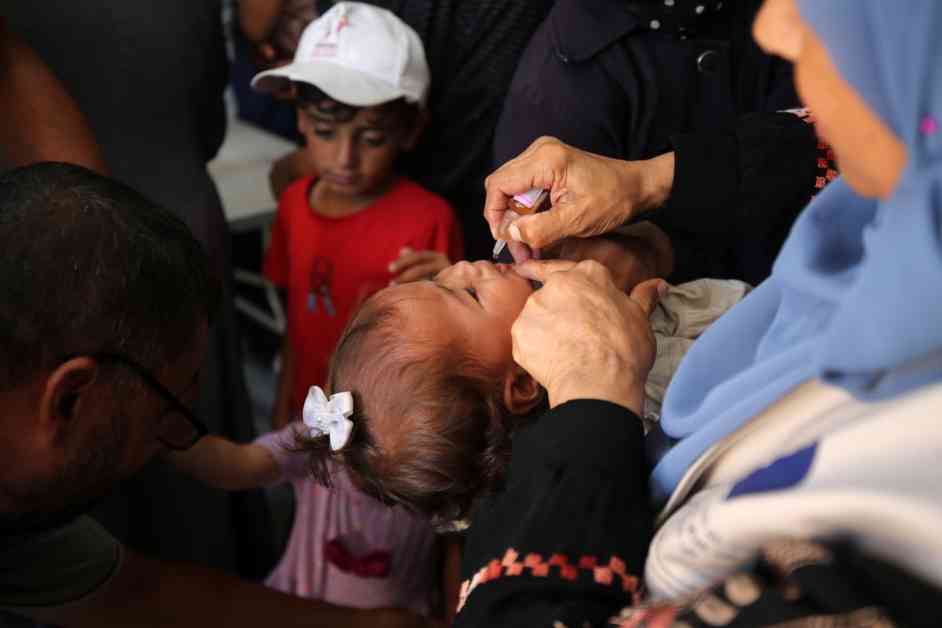The first round of a global effort to vaccinate children in the Gaza Strip against polio concluded in mid-September, with almost 560,000 kids receiving initial doses amid humanitarian pauses in the ongoing war. The alarm was raised in August when a 10-month-old baby boy in Gaza was partially paralyzed by the poliovirus, marking the territory’s first confirmed case of polio in 25 years. This incident confirmed that the poliovirus detected in wastewater in central and southern Gaza was indeed spreading among residents.
Independent monitors are now confirming the exact number of children who received a dose of the vaccine, but the initial round seems to have met the target for herd immunity: at least 90 percent of children aged 10 and under. Relief workers faced challenges while administering doses, operating in brief windows of peace and against a backdrop of mass displacement. However, to fully eradicate the virus, children will need two doses of the vaccine for optimal protection against polio.
The urgency of the vaccination campaign is underscored by the severe impact of polio on children under five, causing lifelong paralysis or even death in some cases. Prior to the conflict in Gaza, 99 percent of residents were immunized against polio. However, due to the destruction of hospitals and displacement of Palestinians, the vaccine coverage rate had dropped to 86 percent by September.
It is challenging to estimate the number of Gazans infected with the virus since the majority of cases do not show symptoms. The few individuals who do may mistake their symptoms for a common cold or flu. The unsanitary conditions in Gaza make exposure to the virus highly likely, as clean water is scarce, sewage is prevalent on the streets, and overcrowded shelters lack proper sanitation facilities.
Children born during the disruption of Gaza’s healthcare system are at the highest risk of paralysis as they may not have received routine vaccinations. The success of the vaccination campaign in Gaza is crucial not only for the children there but also for neighboring areas and globally. The recent resurgence of polio in regions previously considered polio-free highlights the importance of maintaining high vaccination coverage worldwide.
The strain of type 2 poliovirus in Gaza originated from Egypt and is a vaccine-derived virus, highlighting failures in containing the pathogen. The use of the oral poliovirus vaccine (OPV) carries unique risks as recipients can shed the weakened virus in their stool, potentially leading to vaccine-derived cases. Efforts to switch to a safer vaccine have faced challenges, and the recent outbreak in Gaza underscores the need for a comprehensive strategy to eradicate polio.
The ongoing vaccination campaign in Gaza using novel oral polio vaccine type 2 (nOPV2) aims to reduce the risk of vaccine-derived cases. However, the virus in Gaza has evolved from previous use of nOPV2, indicating the challenges in developing a foolproof vaccine. The debate over the best approach to eradicating polio continues among experts, with some advocating for a return to trivalent OPV for routine immunizations.
As public health officials in Gaza prepare for the next round of vaccinations, the success of the campaign hinges on reaching the 90 percent target coverage. Failure to achieve high vaccination rates could result in further spread of the virus within Gaza and beyond. Monitoring wastewater concentrations and polio cases in the region will be crucial in the coming months to track the progress of the vaccination campaign.
Halting the spread of the virus in Gaza would be a significant achievement for the children in the region and for polio eradication efforts worldwide. However, the ongoing conflict in Gaza poses challenges to accessing essential healthcare, putting children at risk of other preventable diseases and threats. Despite the obstacles, the vaccination campaign in Gaza represents a critical step towards protecting vulnerable populations from the devastating effects of polio.










